“That’s How it Was” | Introduction | Wychwood Women : The Interviewees | Declaration of War | The Arrival of Evacuees| School Time | Preparing for War at Home | Soldiers and Airmen | For the Common Cause | Dr Scott and the Canteen | Domestic Life | We Were Lucky Out Here: Food Rationing | Work for Women Outside the Home | The Effects of War
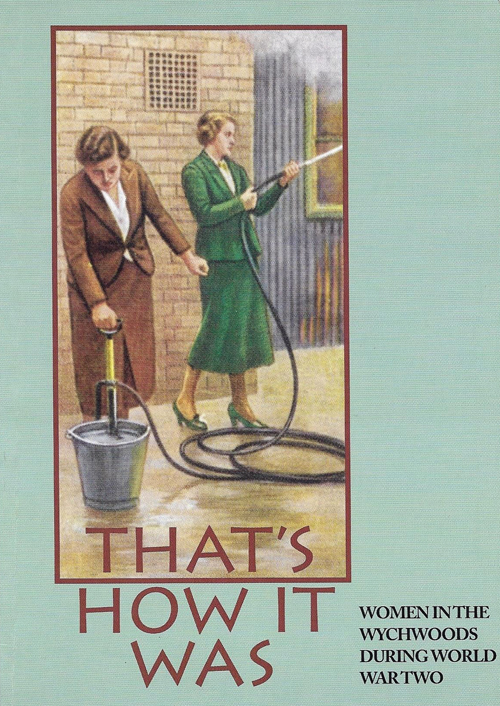
… from the Wychwoods “That’s How It Was” Publication
Voluntary organisations took on important roles during the war with everyone doing what they could in their spare time. Many women were members of Wychwood Women’s Institute, Women’ Voluntary Service, the Red Cross, Mother’s Union, Shipton and Milton Comforts Fund, Wychwood Ambulance and National Savings. There was church and chapel, the British Legion, the Girl Guides, the Boys Brigade, Wychwood Players and the canteen in Shipton. And every one knitted.
The Wychwoods Women’s Institute seemed to have been the main stay of activities in the Shipton and Milton. Cis Miller, Brenda Bishop, Daphne Edginton, Marjorie Rathbone and Rose Burson all belonged. Members knitted, collected salvage, made pyjamas for our prisoners of war and endlessly collected money for refugees and prisoners.
They responded generously to appeals from, among many others, Burford Cottage Hospital, St Dunstan’s Home for the Blind, National Children’s Home, Queen Charlotte’s Maternity Hospital and Great Ormond Street Hospital, the Red Cross, the Wychwood Ambulance and the Empire Cancer Campaign. They helped at the War Nursery at Bruern Abbey and made toys for the babies.
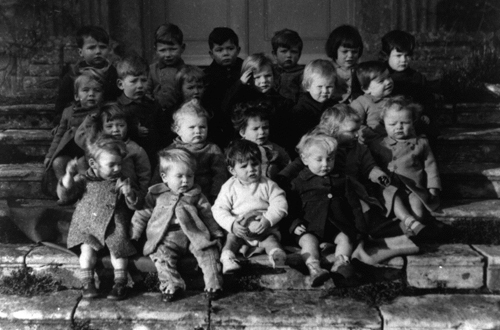
They made lavender bags for London hospitals and air raid victims. They visited evacuees to ‘report on necessitous cases’, entertained refugees and soldiers and evacuated children and their mothers, distributed ration books, held numerous sales of work and whist drives and ran a poultry club and a regular produce stall of vegetables from members’ gardens. In 1943 they were relieved to hear that they were not required to make camouflage nets.
They also ran a Preservation Centre in the ARP room in Groves’ yard particularly worked in by the ladies from across the road in Pear Tree Close, Valerie Davis’ mother, Mrs Timms, Mrs Win Miles and Mrs Bert Gee. The WI minutes for October 1941 record that 240 lbs of jam had been made for sale and that it was intended to make chutney and rose hip syrup. The 12s 4d received for the hips already picked and dispatched would be given to the Russian Red Cross. The following autumn it was recorded that 118 lbs of rose hips had been dispatched for processing and 165 lbs of jam had been made.
Daphne Edginton owned a canning machine that was used for canning sessions with the neighbouring WIs.
‘Plums, there was quite an abundance of plums one year and we did canning and tons and tons of apples one year and we peeled and peeled and peeled and then we canned them. Some at Ascott, some at Chadlington, because they had got facilities. About half a dozen of us.
It took quite a few because you’ve the peeling, and the canning and the sealing of the cans and the boiling and you had to time the boiling properly. And you had to write on them what they were [with a] special pen or dark coloured penciI. Very difficult. They went to a special place; it was all for the common cause in aid of the war effort. So they went off where they needed them, [to] canteens’. Daphne Edgington
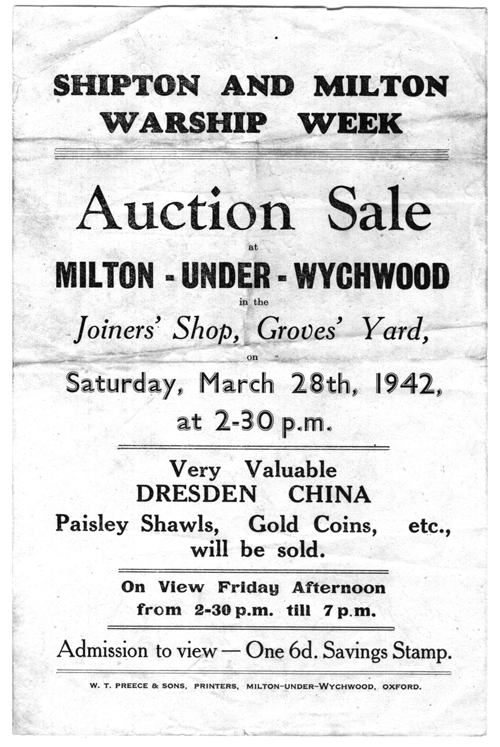
The Wychwood WI meetings were often reorganised because of the problem of meetings during the winter in blackout and air raids warnings and as rooms in the villages were taken over by the military or other organisations. Many talks gave advice on war time problems: ‘Meatless Meals’ and ‘Drying dandelions roots, foxglove leaves and nettles’ and ‘Knitting with unravelled wool’. At some meetings they had cakes and biscuits but no tea and at others no refreshments at all, feeling it their patriotic duty to go without.
As well as all the hard work done by Wychwoods WI, a huge amount was achieved by the Shipton and Milton Comforts Fund, often the same ladies.
In early 1940 the Wychwoods Keep Fit Club – all women – ran a very successful Social and it was decided to send some of the money raised to The Comforts Club inaugurated by the Oxford Mail to send ‘little extras’ to Oxfordshire persons serving in HM Forces.
Dr Scott suggested that there should be a local fund and so commenced the Shipton and Milton Comforts Fund. (Ascott and Lyneham had their own funds).
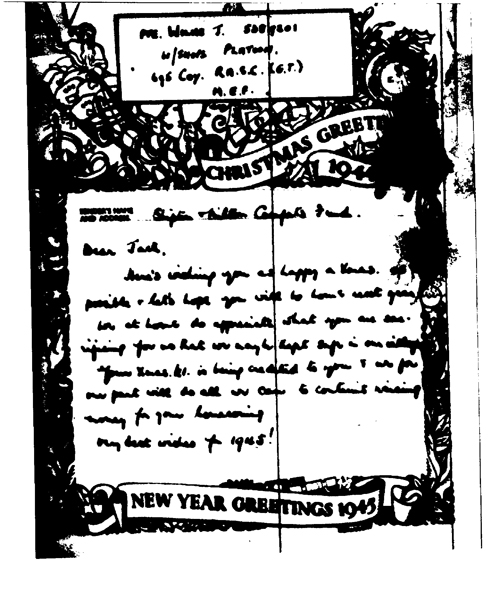
At the beginning of the war, willing knitters had been found to send knitted comforts. By mid-1940 the Fund was able to send to over forty serving personnel a parcel containing a pair of socks, ten cigarettes and a quarter pound bar of chocolate together with a covering letter written by a member of the committee and a stamped addressed envelope for future requests.
The money was raised from socials, weekly whist drives, dances and, by 1943, a pantomime in what had become designated each February as Comforts Week.
In 1941 the committee of the Comforts Fund comprised five women with Mr Fairbairn as Chairman, but it was Mrs Fairbairn as secretary who was the one who ran the whole effort. Meetings were held in her house on the corner of Green Lane as well as the rehearsals of the pantomimes that she produced and for which she provided the musical accompaniment. She was also an active member of the WI.
By 1941 rationing, the cost of postage and other demands on local knitters had made it more difficult to send parcels so money was sent instead. Ten shillings was sent in May 1941 and £1 and 20 cigarettes at Christmas to all those serving in the British Isles together with a covering letter. Those serving abroad were credited with the amount in a Post Office account.
Mrs Fairbairn noted from the replies received ‘[the money] appeared to come in the nick of time, just as they were completely broke’.
Letters were also sent to relatives of those who died on active service together with £5 for needy cases together with any outstanding credits. Throughout the rest of the war members of the forces received letters and money from the Wychwoods. In August 1944 weekly parcels of biscuits, chocolate, a magazine, 40 cigarettes, matches, razor blades and stamps to the total value of eight shillings were sent to those in hospital; not easy with rationing and shortages.
For Christmas 1944 £1 was dispatched to those serving in this country, letters to those in Europe and airgraphs to those elsewhere. With over 120 letters to write and another Comforts Fund Week to prepare, it was agreed that each member of the committee should write at least ten letters. Not quite as easy as it sounds with time spent trying to keep up-to-date with the addresses of forces constantly on the move, buying the correct value postal orders and crediting between 40 and 50 Post Office Saving Books, as well as all the demands of family and home in those days before domestic appliances.
At the end of the war with a substantial amount still in the Fund, it was agreed to give £5 to any member of the armed forces who had served five years and £1 for each year of service to the others, with any remaining balance divided equally between the prisoners of war.
It appears from the Comfort Fund minute book that 166 recipients of this share-out received amounts varying from one shilling and sixpence to £8 15s. And at the end all that was left was the £5 invested by the ladies of the Wychwoods Keep Fit Club.
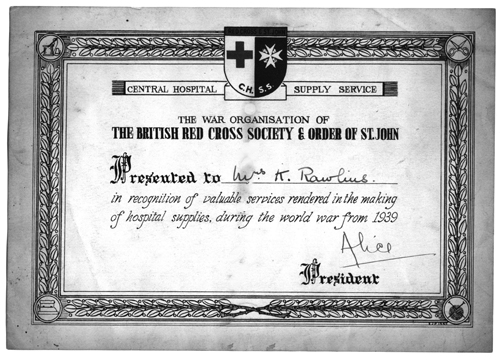
As if the WI and Comforts Fund were not enough work, many also raised money for the Red Cross and collected for National Savings.
Rose Burson recalled ‘We did a lot of Red Cross work. We formed a Red Cross Committee, six of us. I was always making toys. I was soaking felt hats in a bucket of water, then I would iron them out flat and make donkeys and dolls. We made one session, 2000 odd‘.
Marjorie Rathbone’s husband Geoff was always the treasurer for National Saving Weeks. ‘I did collecting, a penny a week for the Red Cross, as I pushed Peter round in his push-chair‘.
“That’s How It Was” Menu
These pages are reproduced from the Society’s publication “That’s How It Was”, featuring women in the Wychwoods during World War Two. The texts and images were published in the year 2000, and deserve a place in our expanding online archive. Please bear in mind as you read our texts in these pages, that we reproduce them as published in the year of publication.
Select from:
“That’s How it Was” | Introduction | Wychwood Women : The Interviewees | Declaration of War | The Arrival of Evacuees| School Time | Preparing for War at Home | Soldiers and Airmen | For the Common Cause | Dr Scott and the Canteen | Domestic Life | We Were Lucky Out Here: Food Rationing | Work for Women Outside the Home | The Effects of War

